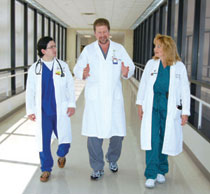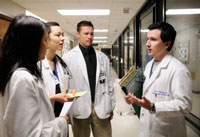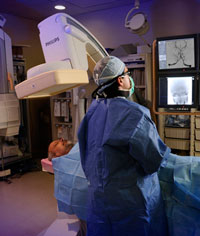http://www.uab.edu/uabmagazine/2010/september/stroke
In 1947, as tension between Russia and the United States threatened to erupt into nuclear war, the Bulletin of the Atomic Scientists added a new element to its cover: a stylized clock face with the hands set at seven minutes to midnight. For the past 63 years, the clock’s minute hand has moved back and forth to reflect the imminence of nuclear holocaust.
In the world of stroke care, the countdown to doomsday begins as soon as the brain’s oxygen supply is disrupted, either through a blood clot (ischemic stroke—the cause of 80 percent of strokes) or by bursting blood vessels (hemorrhagic stroke, which accounts for the other 20 percent of cases). Stroke kills more people worldwide than any other disease. It is the third leading cause of death in the United States and the leading cause of serious, long-term disability.
For years, the stroke clock was set at three hours. Patients receiving emergency treatment before that time stood a good chance of recovering significant function; after the three-hour window closed, there wasn’t much hope. But new advances in stroke treatment are steadily pushing open the treatment window and adding precious time back onto the clock. Neurologist Andrei Alexandrov, M.D., and his team at the UAB Comprehensive Stroke Research Center are contributing many of those breakthroughs, developing and testing revolutionary therapies that are effective several hours, days, and even weeks after stroke onset.
Rescue Squad:
Time Since Stroke – Up to 4.5 Hours
 |
Left to right: Damon Patterson, Andrei Alexandrov, and Anne Alexandrov. Andrei Alexandrov is leading a team of researchers and clinicians testing innovative new stroke therapies. |
Although tPA is very effective at dissolving blood clots and lowering a patient’s risk of permanent disability, many physicians are reluctant to use it. Determining if a stroke victim is a viable candidate for tPA requires specialized knowledge and experience; the drug also increases the risk of bleeding, and administering it requires constant patient monitoring. Then there is its strict timeframe: tPA must be used within three hours of stroke onset—or so many physicians think. But that last restriction is no longer accurate, Alexandrov says. The American Stroke Association now supports use of tPA up to 4.5 hours from stroke onset.
UAB’s stroke unit is testing several ways to enhance tPA administration. In 2009, 40 patients at UAB were treated with intra-arterial rescue therapies, which include direct delivery of tPA to the clot in the brain, as well as use of devices capable of retrieving blood clots and stents that can keep arteries open. While there are currently no studies that show this type of treatment to be superior to tPA, it does provide an ability to treat stroke beyond the 4.5-hour window, Alexandrov says.
 |
Interventional stroke neurologist Damon Patterson (right) and medical students in UAB's universal concept stroke unit. |
| The Unit When Andrei Alexandrov, M.D., joined UAB in 2007 as director of the university’s Comprehensive Stroke Research Center, one of his first moves was to establish a “universal concept stroke unit.” Whereas stroke patients were once scattered across the hospital, Alexandrov’s unit concentrates all critically ill stroke patients on the same floor—and those patients stay in the same room, with the same highly educated nursing and therapy team, from admission to discharge. The unit “is one of the first of its kind in the world,” Alexandrov notes. “This is essentially a one-stop unit with highly specialized interdisciplinary practitioners able to provide the latest scientific, evidence-based care and conduct cutting-edge clinical research.” |
Alexandrov is now testing tiny, gas-filled “microspheres” that are delivered to the clot, then agitated using a small beam of ultrasound waves. (?Is this xenon gas? Is the gas the working object or the ultrasound?)When the ultrasound beam intercepts the bubbles it causes them to explode into the clot. In combination with tPA, these bubbles may help to break up the clot even further. In clinical trials conducted at UAB, ultrasound therapy was able to break up clots with twice the success rate of tPA alone.
Typically, tPA works primarily by partially breaking up a clot so that blood flow is established to areas of the brain deprived of oxygen; but tPA only breaks up clots completely 13 percent of the time. Alexandrov says his goal is to refine the ultrasound combo therapy to the point where 50 percent of clots are completely broken up in the ER.
But ultrasound therapy faces a major obstacle before it can achieve widespread use: Only a handful of people in the world have enough training to administer it properly. “Most stroke neurologists don’t know how to do it,” Alexandrov says. “People are excited, but few of them can use the technology.” So Alexandrov has developed an automated treatment “helmet” that fits over a patient’s head and will allow emergency-room personnel to provide the therapy with only limited prior training. “It’s just like putting on a pair of glasses,” Alexandrov says. He has been tapped by the National Institutes of Health to lead a worldwide clinical trial to test the efficacy of the helmet; the trial will launch in 2011.
Saving the Brain:
Time Since Stroke – Up to 4.5 Days
 |
UAB interventional stroke neurologists such as Damon Patterson use new techniques to remove clots deep in the brain up to several days post-stroke. |
UAB is a nationally recognized leader in endovascular therapy, and its physicians frequently receive calls from other hospitals about their stroke cases, says Patterson. “We listen to their report and advise administering tPA if it’s appropriate,” he explains. “Then we rush the patient here to our cath lab in order to extend the response time window and hopefully provide a good outcome.”
Seven to eight hours post-stroke is generally regarded as the effective limit for neuro-endovascular therapy, Patterson notes, but new imaging techniques are allowing physicians to widen that timeframe. “Each person’s brain is unique and responds to a stroke in its own way,” he says. “New ways of looking at the brain quickly, such as reperfusion, allow us to determine which parts of the brain are already damaged and which parts are at risk of becoming damaged. We then use that info to determine if there is enough brain to save and if it’s going to be safe to try to save it.”
This makes rigid treatment timelines obsolete, Patterson says. “With these newer devices, we can extend the time window almost indefinitely.” Those extra hours are especially useful when treating “wakeup strokes”—when people wake up in the morning with symptoms, Patterson explains. “You have to go back to when they were last seen normal, which most of the time is when they went to bed the night before. We don’t know at what point during the night that the stroke actually started. With perfusion imaging, we might see that there is a whole bunch of brain to save and very little has been permanently damaged. It’s also wonderful because we’re able to extend time windows so that rural hospitals without these imaging capabilities can get stroke victims to us.”
UAB neurologists recently used neuro-endovascular therapy to remove a clot from a patient an unheard-of four-and-a-half days after stroke onset.
No comments:
Post a Comment